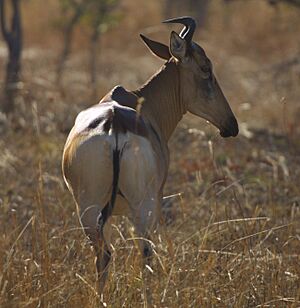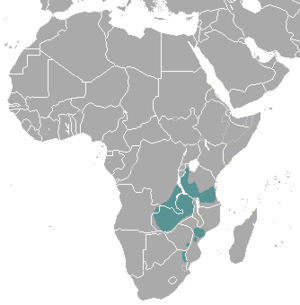Lichtenstein's hartebeest facts for kids
Quick facts for kids Lichtenstein's hartebeest |
|
|---|---|
 |
|
| In the Kafue National Park, Zambia | |
| Conservation status | |
| Scientific classification | |
 |
|
| Distribution of Alcelaphus buselaphus lichtensteinii | |
| Synonyms | |
|
Sigmoceros lichtensteinii |
The Lichtenstein's hartebeest (Alcelaphus buselaphus lichtensteinii) is a type of hartebeest. This antelope lives in the savannahs and wet floodplains of Southeastern and Central Africa. Some scientists think it might even be its own special species, called Sigmoceros lichtensteinii.
It got its name from a zoologist named Martin Lichtenstein.
Contents
What Lichtenstein's Hartebeest Look Like
Lichtenstein's hartebeest usually stand about 1.25 meters (4.1 feet) tall at the shoulder. They weigh around 150 kilograms (330 pounds). Their fur is a reddish-brown color. It is lighter on their belly.
Both male and female hartebeest have horns. From the side, their horns look like the letter 'S'. From the front, they look like the letter 'O' with the top part missing. The horns are a bit bumpy and can grow longer than 0.5 meters (1.6 feet).
How Lichtenstein's Hartebeest Live
Daily Life and Habits
These animals live in areas where they can eat grass. They are diurnal, which means they are active during the day. They usually live in groups, called herds. A herd often has five to 15 females and their young calves. One male hartebeest leads the group.
The male hartebeest acts as a lookout. He often stands on high spots like termite mounds to watch for danger. Lichtenstein's hartebeest have good eyesight. However, their sense of smell is not very strong. Their main sounds are a loud bellow and a sneeze-snort sound.
Territory and Herds
Lichtenstein's hartebeest are very territorial. This means males claim large areas of land as their own. They mark their territory by digging up soil with their horns around the edges. Male hartebeest do not let other males into their space.
Herds usually have between 1 and 10 animals. It is rare to see a herd with more than 10 individuals. The largest groups are often seen in August or September. This is usually when most calves are born. Bigger groups might help protect the newborn calves from predators.
Younger, single males often live alone. They do not try to claim a territory. However, older solitary males will defend their own areas. For every male hartebeest, there are usually about 2 to 3 females.
Reproduction and Breeding Season
The breeding season for Lichtenstein's hartebeest is called the rutting period. It typically runs from mid-October to January. This timing can be a little different depending on the location.
During this time, bachelor males might challenge the lead males. They fight until one is completely tired. This is how they try to take over the females in a territory. Hartebeest have special ways of defending their territory. They might paw at the ground or use their horns to dig. They also rub their head against their shoulder. When they are alarmed, they might shake their head up and down quickly. Hartebeest also mark their territory by making piles of dung.


